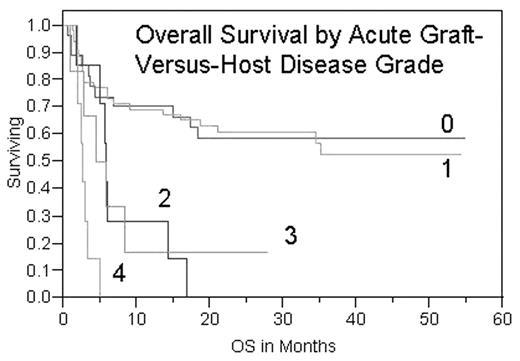Abstract
Grade 2–4 acute graft versus host disease (aGVHD) is associated with decreased overall survival following conventional allogeneic stem cell transplantation but its impact on reduced intensity transplantation remains controversial. We evaluated the impact of grade 2–4 aGVHD on survival in a retrospective review of 112 high-risk patients, median age 50 (range 18 to 70), with AML (n=29), MDS (n=19), CML (n=9), CLL (n=5), ALL (n=3), HD (n=10), NHL (n=16), MM (n=9), MMM (n=7), PNH (n=2), or renal cell carcinoma (n=3), who underwent a reduced intensity preparative regimen of extracorporeal photopheresis day −7, −6, pentostatin 8mg/m2 by continuous intravenous infusion day −5 thru −4, and total body irradiation in three 200cGy fractions day −3, −2, followed by allogeneic bone marrow stem cell infusion from a 6/6 HLA matched related (n=70), 5/6 HLA matched related (n=10), or matched unrelated (n=32) donor. All patients were high-risk, including 30 patients with a prior autologous stem cell transplant and 5 patients with a prior allogeneic stem cell transplant. Full donor chimerism at the time of neutrophil engraftment was achieved in 89% of patients. The median time to neutrophil and platelet engraftment were 19 and 21 days respectively. Day 100 transplant related mortality(TRM) was 20%. Disease relapse occurred in 22% of patients. Grade 0 or 1 aGVHD occurred in 27 patients (27%) and 54 patients (54%) respectively. Grade 2, 3 or 4 aGVHD occurred in 7 patients (7%), 6 patients (6%), and 7 patients (7%) respectively. The one-year overall survival (OS) by aGVHD grade was 70% for grade 0, 69% for grade 1, 29% for grade 2, 17% for grade 3, and 0% for grade 4. Grade 2–4 aGVHD was associated with a significantly increased day 100 TRM (37% vs 14%: p=0.03), decreased median failure-free survival (5 months vs 35 months: p=0.001), and decreased median OS (5 months vs “not reached”: p=0.001). The decrease in median OS among patients with grade 2–4 aGVHD was significant among matched related donor transplants (5 months vs “not reached”: p=0.002) and among mismatched related or matched unrelated donor transplants (6 months vs 35 months: p=0.0004). There was no significant difference in median OS between patients with grade 2 aGVHD and patients with grade 3–4 aGVHD (6 months vs 3 months: p=0.24). Patients with limited or no chronic GVHD (cGVHD) had similar one-year OS (90% vs 79%) but patients who developed extensive chronic GVHD had a significantly worse median OS (56% vs “not reached”: p=0.001). In conclusion, high-risk patients who undergo reduced intensity transplantation and develop grade 2–4 aGVHD or extensive cGVHD have a significantly decreased overall survival. Patients with grade 2 aGVHD have similarly poor OS as patients with grade 3–4 aGVHD. High-risk patients tolerate GVHD poorly with a significantly decreased overall survival. To improve survival, reduced intensity transplantation regimens that decrease the incidence of grade 2–4 aGVHD or extensive cGVHD need to be developed.


This feature is available to Subscribers Only
Sign In or Create an Account Close Modal